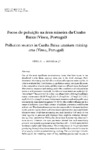Mostrar o rexistro simple do ítem
Focos de poluição na área mineira da Cunha Baixa (Viseu, Portugal)
| dc.contributor.author | Neves, O. | |
| dc.contributor.author | Matias, M.J. | |
| dc.date.accessioned | 2016-08-26T10:40:50Z | |
| dc.date.available | 2016-08-26T10:40:50Z | |
| dc.date.issued | 2004 | |
| dc.identifier.citation | Cadernos do Laboratorio Xeolóxico de Laxe: Revista de xeoloxía galega e do hercínico peninsular, ISSN 0213-4497, Nº 29, 2004, páxs. 187-202 | es_ES |
| dc.identifier.issn | 0213-4497 | |
| dc.identifier.uri | http://hdl.handle.net/2183/17240 | |
| dc.description.abstract | [Abstract] One of the most significant environmental issues that have arisen in the abandoned Cunha Baixa uranium mine area is the Acid Drainage (AD). Downward the mining site AD affects surface and irrigation water quality. ln order to evaluate their contribution as a pollution source, this paper discusses: i) the composition of mine water, pit lake water and effluent water discharged after chemical treatment and settling, and ii) the conrribution of rocks and mine wastes as acid generators materials. Pit lake and mine waters are acidic (pH 3- 4) with high 226 Ra activity (1.8-12 Bq/l), sulphate (1000-2400 mg/l) and heavy metals concentration (Al: 8-70 mg/l; Mn: 4-35 mg/l; Fe: 1-55 mg/l; U: 1.2-6.3 mg/l; Zn: 0.5-2.9 mg/l). ln spite of mine water treatment and settling efficiency to remove the main dissolved species (50-80 %), the overflow effluent can be a source of pollution, due to high contents of sulphate, uranium as well fluorine and calei um. The chemical treatment was also responsible for the water hardness in this granitic region. Rocks and mine wastes submitted to static and kinetic laboratory tests (Acid-Base accounting test and Humidity Cell test) did not show capacity to generate acid drainage from sulphide oxidation through testing rime, nevertheless Thiobacillus ferrooxidans bacterium was detected in mine waters. However, the open pit wastes showed low acid neutralising potential and capacity to generate an acid leachate (pH < 5) with potentialities to release sulphate and heavy metals. The running water or the pit lake water percolating through these wastes was able to mobilise elements and increase its dispersion by contínuos contaminating leaching. The acid drainage in Cunha Baixa can be the remaining result of heap leaching process used in past, to recover uranium from low-grade ore when opening the pit area, although this process ceased in 1993. | es_ES |
| dc.language.iso | por | es_ES |
| dc.publisher | Universidade da Coruña | es_ES |
| dc.subject | Uranium | es_ES |
| dc.subject | Acid drainage | es_ES |
| dc.subject | Environmental pollution | es_ES |
| dc.subject | Hydrogeochemistry | es_ES |
| dc.subject | Cunha baixa mine | es_ES |
| dc.title | Focos de poluição na área mineira da Cunha Baixa (Viseu, Portugal) | es_ES |
| dc.title.alternative | Pollution sources in Cunha Baixa uranium mining area (Viseu, Portugal) | es_ES |
| dc.type | info:eu-repo/semantics/article | es_ES |
| dc.rights.access | info:eu-repo/semantics/openAccess | es_ES |
| UDC.journalTitle | Cadernos do Laboratorio Xeolóxico de Laxe | es_ES |
| UDC.issue | 29 | es_ES |
| UDC.startPage | 187 | es_ES |
| UDC.endPage | 202 | es_ES |






